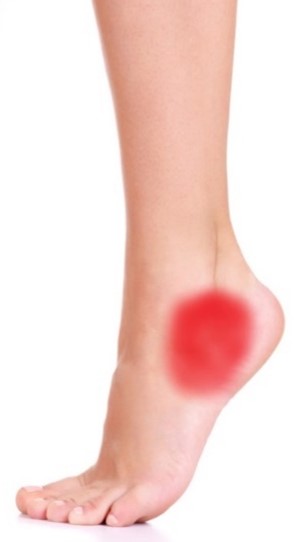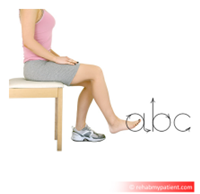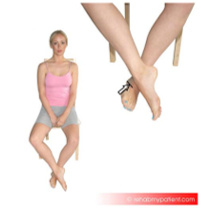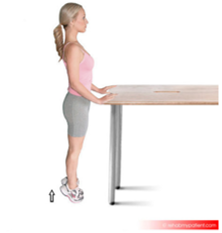Outer Ankle Tendon Pain
Information and exercise leaflet for
patients and carers

What is the Peroneal Tendon?
Tendon pain on the outer side of the ankle is called Peroneal Tendinopathy. The Peroneal tendon is a cord-like structure that attaches a muscle on the outside of your lower-leg to the outside of your foot.
When the Peroneal tendon lifts the outer edge of your foot and is very important for walking and balance.
What is Peroneal Tendinopathy?
Tendinopathy is a condition that involves pain and reduced strength in a tendon. This often occurs following a change in activity levels. It may result from doing more activity than previously, however it can also be a result of doing less than you would normally for example, after a period of illness or extended rest.
If you have a Peroneal Tendinopathy, you will likely experience pain on the outer aspect of your foot and/or just behind your outer ankle bone (lateral malleolus).
The result is that the irritated tendon means the activities you do now are too much for you to tolerate. Therefore, you get pain.
Common features
Most people will experience pain after rest and first thing in the morning.
When following the correct advice and rehabilitation programme full recovery can take between 3 and 12 months.
Should I be resting or moving?
You are safe and generally better off if you move. There is no evidence to suggest your tendon is at greater risk of damage with more activity.
If you keep still and significantly reduce your activity levels, your tendon may become more irritated, and your muscles will become weaker leading to further pain and reduced strength.
Activity Diary and Modifications
It is sometimes useful to make a note of the daily activities that can potentially aggravate your symptoms. Below are some of the main aggravators and some modifications you can make to help reduce the painful reaction.
| Aggravator | Modification |
|---|---|
| Walking on uneven ground | Ensure you wear supportive footwear. Often an ankle/lace-up boot can give extra stability and reduce the strain on the tendon. |
| Sitting down or resting for too long | Try to avoid prolonged rest. Break up periods of sitting by getting up and moving every 20-30 mins. |
| Exercising through pain and for prolonged periods. | Use the reaction rules guide below to ensure that you do not cause a painful reaction. |
How do I know if I am doing too much?
It is common to get a painful reaction if too much load is put through the tendon. If this pain is more than 5/10 (with 10 being the worst pain imaginable) and lasts for more than 24 hours, check what you have been doing and ease back, not necessarily stop/avoid in future.
Once this has settled you can start to gradually introduce your activities and exercises again. If you have a mild aggravation (pain is less than 5/10) and this settles within 24 hours then keep going with your exercises and gradually return to full activities.
Pain relief and injections
Painkillers can help you keep moving. However, it is important to discuss this with your GP, especially if you are taking any other medication.
Injections are not recommended for this problem.
Ice
You could try applying ice after activity to help reduce pain and/or inflammation.
If you experience reduced sensation, numbness, or have circulatory problems you should discuss the use of ice with a healthcare professional prior to using them. Ice can burn skin; therefore, you should always use a towel to cover the area and check their skin regularly for any changes and signs of burning. A damp towel is more effective when applying ice.
Always mark the packet of frozen peas before putting them back in the freezer as they would be unsafe to eat after being defrosted numerous times.
What about sports or work?
You should use the previously mentioned reaction rules to highlight whether a return/adaptation to sport or work is advisable.
Do I need any tests?
Peroneal Tendinopathy is diagnosed clinically. Scans and other investigations are often not recommended as they are not required.
What are the aims of Physiotherapy?
The aims of physiotherapy are to improve muscle strength, load tolerance and pain in your tendon. This should allow you to return to your previous activities.
General measures to help
Weight control
If you are overweight, try to lose some weight as the extra burden placed on your tendon can make symptoms worse. Even a modest weight loss can make quite a difference.
Poor diet, high cholesterol and diabetes are linked to an increased risk of developing a tendinopathy and poorer healing.
Warning Signs
If you develop new or worsening symptoms, if you are unwell with the pain, or under the age of 16 years, seek medical advice.
The following symptoms are very rare, but if you suddenly develop any of them, you should seek urgent medical attention at your local Urgent Care Centre.
- Sudden onset of Achilles pain, with a “pop” or snapping sound/sensation.
- Inability to weight-bear through the foot/ankle.
- New significant injury to the leg/foot/ankle.
- Constant night pain in the foot/ankle (that prevents rest/sleep).
- Significant swelling, colour change or temperature change in the foot/ankle or extending up the leg.
- Lumps in the foot/ankle.
- Signs of infection i.e. night sweats that are out of the ordinary, high temperature and feeling unwell.
- Unexplained weight loss
If your symptoms fail to improve within 6-8 weeks with this regime you should contact your doctor for a physiotherapy referral.
If your symptoms are improving (even slowly), continue for up to 3 months.
Exercises for Peroneal Tendinopathy
Do not work into pain but it is ok for your muscles to feel tired. If the number of repetitions or length of the hold is too long, back off slightly, but aim to build up to the stated level.
Use the reaction rules to guide your exercise intensity. If pain is stopping you engaging in rehab, you should speak to your GP about pain relief promptly.
Flare-ups may happen; if it doesn’t settle in a couple of weeks, then seek further advice.

Alphabet Ankle Sitting
Sitting bare foot, lift your foot off the floor. Use your toes and ankle to draw letters of the alphabet. Start with "a" and then progress right through the alphabet to "z". Keep each letter and movement controlled and specific.
Hold for 30 seconds Repeat 5 times 3 times daily

Self-Resisted Eversion
Sitting on a chair, cross your feet keeping your heels on the floor. Push the outside of your feet against each other. This is a strengthening exercise for your ankles.
Hold for 30 seconds Repeat 5 times 3 times daily

Calf raises
Stand upright and hold onto a wall/table for balance if required. Slowly raise up onto your toes and control the movement back down. This exercise will strengthen the calf muscles and ankle joints. Repeat for the repetitions suggested, or until muscle tiredness or discomfort
Repeat 10- 30 reps 3 times daily
Once you are able to perform 30 repetitions in one go, progress to trying to do it on the affected leg only, holding on to something for balance

One leg Stand
Stand on one leg and try to keep your balance. Be careful and hold on to a wall for support when you first start this exercise. A single leg balance exercise such as this is an enormously valuable exercise, and its benefits including strengthening the muscles and ligaments around the ankles and knees and improving balance.
Hold for 30 seconds Repeat 5 times 3 times daily
Build up to holding for 2 minutes
What actions can I take to improve my health?
Evidence tells us that making healthy lifestyle choices can have a big impact on influencing problems with your muscles and bones and can play a major role in your overall health. Some of the most effective areas to address are below: (click on the links)
Maintaining a healthy weight - www.nhs.uk/live-well/healthy-weight/
Increasing levels of physical activity - http://www.nhs.uk/live-well/exercise/
Avoiding poor sleep patterns - www.nhs.uk/live-well/sleep-and-tiredness/how-to-get-to-sleep/
Reducing alcohol consumption - https://www.nhs.uk/live-well/alcohol-support/calculating-alcohol-units/
Stopping smoking - http://www.nhs.uk/live-well/quit-smoking/
Maintaining a healthy mind - http://www.nhs.uk/conditions/stress-anxiety-depression/
The good news is that you are able to influence lots of these by modifying your lifestyle. Therefore it is important that you consider addressing these areas alongside your current treatment.
You may wish to discuss any of these factors with your treating clinician who will be able to work with you and guide your long term management and support you to improve your wellbeing.
There will be information about the local services that exist within the waiting areas of the physiotherapy department and your treating clinician will be able to help signpost you to appropriate services.
The websites listed below give more information on local services available:
• Blackburn and Darwen - https://refreshbwd.com/
• East Lancashire - http://www.upandactive.co.uk/
• Public Health England https://www.gov.uk/government/organisations/public-health- england
You can download a printable version of this information here.
Please note this is a PDF and does not meet accessibility needs.


